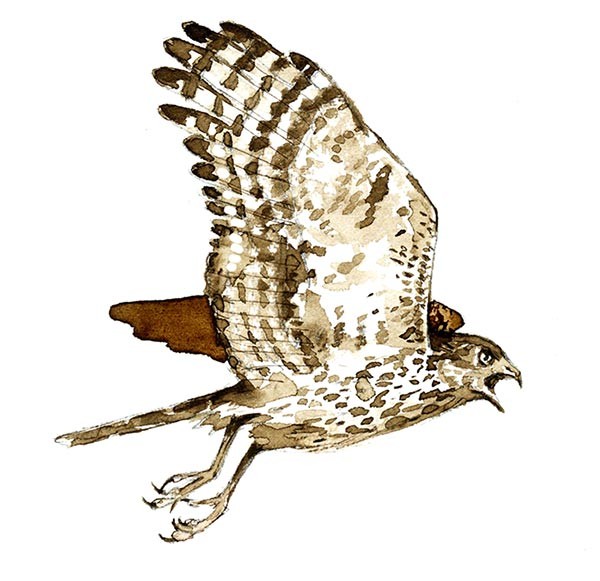
I was enjoying a morning cup of coffee in the sunroom when I saw the hawk. It was perched across the road, maybe 30 yards away, its chest puffed up against the cold. It appeared to be eyeing the activity at our birdfeeder. As I was trying to decide if it was a female sharp-shinned hawk or a male Cooper’s hawk, the bird launched from its perch, and in an instant had threaded its way through a dense tangle of road-side branches while in hot pursuit of a blue jay. It all happened so quickly that I wasn’t even sure if the jay had been captured, although I was able to identify it as a Cooper’s hawk.
The Cooper’s hawk is one of three North American species in the genus Accipiter, along with the smaller sharp-shinned hawk and the larger northern goshawk. The silhouettes of this trio look like a set of nesting cookie cutters, each with the same basic shape, differing only in size. As I witnessed, accipiters are sit-and-wait, stealth predators, capable of quick bursts of speed and exceptional maneuverability — much like a motorcycle racing down a winding mountain road.
The motorcycle hawks are bird-hunters, and according to the Latin meaning of the word Accipiter, they are also the “true hawks.” They are the nemeses of other birds large and small, chasing down their avian prey in short bursts of speed. As Pete Dunne points out in his classic book, Hawks in Flight, “…the true hawk is a sprinter. If prey is not taken in the first attempt or after a short chase, pursuit is broken off. Surprise is the ally of an accipiter, not endurance.”
If surprise is their ally, then acceleration and maneuverability are their weapons. An accipiter’s long, rudder-of-a-tail provides the precise cornering ability needed to follow the twisting and turning escape flight of smaller birds. The speed to overtake its passerine prey is provided by rounded wings, which catch enough air to generate a quick burst of speed, while short wing length allows the accipiter to slip through dense woodlands without crashing into branches.
Or does it?
Surprisingly, a study lead by Aaron Roth of Northeastern University, which examined 339 skeletal specimens of accipiters from museum collections, found that nearly 20 percent had healed fractures of the pelvic girdle, primarily to the wishbone. While it’s easy to imagine that dashing through dense vegetation at high rates of speed in pursuit of other birds is a rather dangerous lifestyle, and that impact injuries are likely to occur, it is surprising that such a high proportion of accipiters are able to recover from broken bones, especially considering the importance of flight to their hunting style.
The smallest member of this trio, the sharp-shinned hawk, occupies the narrowest niche. These compact bundles of energy primarily capture small, sparrow-size birds. That said, when the opportunity presents itself, they can be more ambitious. (I once saw a “sharpie” take a blue jay, a bird that it nearly equaled in size, but which the hawk must have out-weighed two to one.)
The medium-sized Cooper’s hawk, not unexpectedly, preys primarily on small to medium-sized birds. However, thanks to their larger size, Coopers occupy a broader niche and often include chipmunks and squirrels in their diet. They nest in a wide variety of woodlands, and are becoming more common in suburban areas. This is our most commonly observed accipiter during winter months.
If accipiters are motorcycles, than the northern goshawk is a Harley. Their size and power, combined with their maneuverability, provide this year-round resident with a wide variety of prey items. Across the Northern Forest, the staple of these powerful hawks may be ruffed grouse and snowshoe hare, but pity any small to medium-sized animal unlucky enough to find itself in the blood-red gaze of a “gos.”
As with most birds of prey, accipiters exhibit “reverse sexual dimorphism;” females are nearly a third larger than males. This allows a pair to have a greater range of prey choices — smaller hawks are better able to catch small prey, while their larger mates can catch larger animals — though it remains unclear why females are the larger sex.
In general, accipiters are a shy bunch. They are difficult to observe, and other than during migration, stick mostly to the deep woods. If you’re lucky enough to see one slipping through the shadows, or lurking near your birdfeeder, savor the moment.


Discussion *